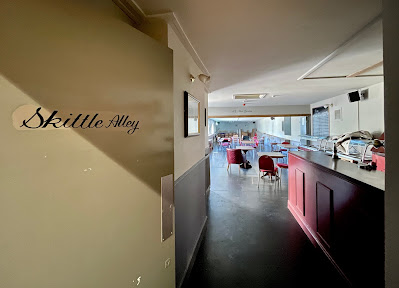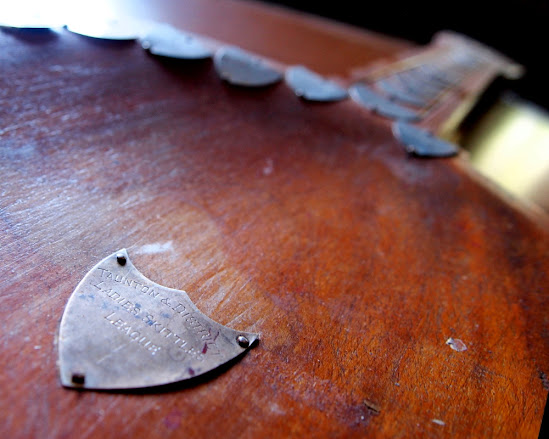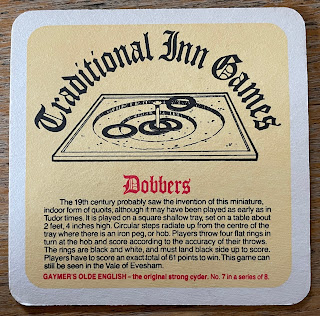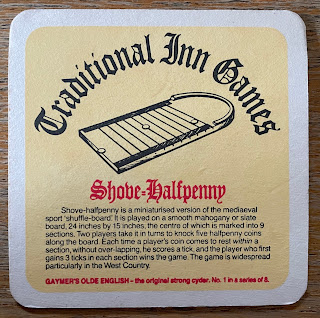Friday, 10 September 2021
The End
Thursday, 22 July 2021
Bell Inn, St Johns, Worcester
So, what little remains of these historic gems is precious indeed, and well worth supporting with a visit and a pint or two. The beauty of Worcester is that all its rare pub survivors might conceivably be visited in a single day without too much trouble, and I'd have to say that they’re all well worth visiting. From Worcesters oldest pub, to a classic post-war estate boozer, all unique and attractive venues in their own very different ways. Having said that, it's perhaps worth mentioning that these are not mere tourist attractions, they are for the most part vibrant, sometimes busy locals pubs, in fact some might be regarded as being quite earthy in character, splendidly so in my view.
One such 'earthy' locals pub is the terrific Bell Inn over the river in the village suburb of St Johns (also home to the mothballed Bush Inn). The Bell has already featured on this blog, though every time I’ve been there previously it's been a little too busy to brandish a camera freely, making it quite a brief mention. My most recent visit was a quieter affair, the mid-afternoon lull before the storm of a Friday night session. A smattering of locals in the long bar, several more basking and baking in the garden to the rear of the pub on what was one of the hottest days of the year.A classic urban all-day opener (10am Mon-Sat!) on the main road through St Johns, the only nearby competition coming from the Parish Church opposite now that the Bull Baiters micropub seems to have closed. Indeed the pub was originally established to serve parishioners as a Church House, the origin of many village pubs it seems. As much a social centre as beerhouse, though the predominantly local beers on offer are certainly worth sampling. The chat and banter in the bar is constant, sometimes loud, often rude, occasionally lewd, it's that kind of pub. A telly at the front of the bar seems to be reserved exclusively for horseracing, and whilst other sports do feature when requested, I wouldn't say the Bell is a particularly 'sporty' bar. If it's on it's on, if it's not, nobody seems particularly bothered, there's a lot of chat to catch up on.
Friday, 9 July 2021
Princess Royal, Taunton, Somerset
Nevertheless, pubs and clubs continue to close, in some cases permanently, and clearly we're very far from out of the woods with this terrible pandemic just yet. After an initial rush back to the pub this Summer, trade does seem to have slowed somewhat, and it's now more difficult than ever to find a pub open at the less busy times of the week/day. So when we do find a pub maintaining the traditions of all-day opening, with a warm welcome and nice cool pint on a hot midweek afternoon, as I did in Taunton quite recently, it's certainly something worth shouting about I think.
Sunday, 27 June 2021
Lethbridge Arms, Bishops Lydeard, Somerset
 At the risk of employing a rather flimsy excuse as an introduction to this post, the game of Fives has been on my mind a little more than usual of late. My friend and fellow pub games enthusiast John Penny started it all off with a feature he wrote on the game earlier this year for Visitor Magazine. A much more in-depth and informative piece than I'll attempt here, and I urge you to follow the link and read it from page 20 for a better understanding of the game.
At the risk of employing a rather flimsy excuse as an introduction to this post, the game of Fives has been on my mind a little more than usual of late. My friend and fellow pub games enthusiast John Penny started it all off with a feature he wrote on the game earlier this year for Visitor Magazine. A much more in-depth and informative piece than I'll attempt here, and I urge you to follow the link and read it from page 20 for a better understanding of the game.
John is of course a Dorset man, as evidenced by his sometimes impenetrable Dorsetshire accent and a deep love of Dorset's national sport, Alley Skittles. John plies his skittling trade, with some success it must be said, at the famous Rose & Crown in Bradford Abbas, and more widely at away matches in Dorset and over the border in Somerset. So a rare pub gaming tradition almost unique to neighbouring Somerset was never going to escape Johns keen eye for long, even if it's now effectively an extinct tradition as far as the pub is concerned.
Fives as a competitive game dates back several centuries, and was widely played throughout the country and latterly exported to the then colonies. A form of Handball that requires nothing more complex to play than a solid wall, a ball with some measure of bounce, and tough or gloved hands. As far as Somerset is concerned, the game seems to have developed and become popular when played between the buttresses of a church tower (indeed surviving walls are still known as 'Towers'), which would probably have been the only suitable 'court' available to ordinary folk at the time. I don't know whether the example shown here on the north side of Carhampton Church is known to have been used for the game, but the basic form and a clearly delineated line a couple of feet up is typical, and would have certainly made it possible.The surviving Fives Towers in Somerset may no longer be in use, but they represent a great opportunity for tourists like myself to visit, often being handy for pubs and of course eminently 'collectable'. A cluster of surviving Towers near Yeovil would make for an easy tour, but I visited an outlier at the Lethbridge Arms in the village of Bishops Lydeard to the north of Taunton. Bishops Lydeard is perhaps more famous these days as the eastern terminus of the West Somerset Heritage Railway, making a visit to the Lethbridge even easier for tourists in the Minehead area.
The impressive Fives Tower at the Lethbridge Arms stands as a boundary between the pub car park and an adjacent cottage. Built of stone with a more 'even' red brick facing, the tall self-supported structure is strengthened by sturdy buttresses to the side (right) and rear (below). It's clear that the game would have been played and spectated from the rear of the pub itself. Albeit that it now abuts the pubs busy car park, the Fives Tower at the Lethbridge could quite easily be used for a game even now should anyone fancy a revival.
Saturday, 19 June 2021
Kildare Lodge, Minehead, Somerset
North Somerset has long been a regular haunt of mine, and an occasional holiday spot since teenage years. The stretch of coastline around Minehead a particularly happy hunting ground for pubs, beer, and strong local cider. I usually take advantage of the West Somerset heritage rail line for trips to Dunster, Watchet, and of course a day of sun, sea, fish and chips in the attractive tourist trap of Minehead. There are some very fine pubs to be found in the area if you know where to look, one of which, the Kildare Lodge, has been on my to-do list for some time now, so I was delighted to finally pop in for a couple of pints this year.
I find most pubs are attractive in their own way, even the much derided post-war estate pubs can have a unique 'vintage' visual appeal that transcends their somewhat utilitarian origins. Few pubs are as jaw-droppingly gorgeous as the grade II* listed Kildare Lodge though. As you can see from these photos, Kildare Lodge is a truly stunning Arts and Crafts styled building, beautifully maintained for the benefit of locals and visitors who clearly appreciate the pubs unique architecture and ambiance, as well as the very good range of local ales on offer. Originally built as a residence and surgery for a local doctor, the building is now in the hands of Harvey & Sarah Pyle, sensitively altered and re-purposed for its current important role in the local community.
Somerset is, of course, at the very heart of a very well supported West Country Skittles tradition, indeed there are still a fair few alleys at pubs and clubs in the Minehead area for the game. Boules (also known as Petanque) is a relative newcomer, the local league having been established less than 20 years ago but now grown to three divisions. This probably makes Boule the more popular of the two games in this area, certainly during the warmer Summer months when Skittles leagues often contract due to other player commitments. Whatever the reality, it's easy to understand the appeal of Boule as a Summer game at Kildare Lodge.
Monday, 3 May 2021
Traditional Inn Games - The Gaymer's Cyder Beermat Collection
Pub gaming ephemera and equipment has long been a medium for drinks and tobacco companies to advertise their wares. Playing Cards, Dominoes, Darts Flights and Scoreboards were all commonly appended with Brewery names and Tobacco brands, and along with league sponsorship there are few areas of the pub games tradition that would have escaped the marketing departments attention.
In truth, I doubt whether this kind of advertising was intended to sway drinkers and smokers one way or the other to any great degree, all pubs being very firmly tied to their respective breweries back then. I'd imagine that then, as now, drinker and smoker preference was based largely on personal taste, price, and choice of pub rather than the hard sell of an attractively branded Cribbage Board. These items were more about brand loyalty, cheap or free tokens available to customers as part of the all-important 'sales rep - licensee' relationship.So customers got to play their favoured games at the pub without the added expense of having to supply their own equipment, and the drinks and tobacco industry obviously saw the value of rewarding valued customers with relatively inexpensive branded tokens of their appreciation, thereby cementing the relationship between brand and customer. The legacy of all this of course, is a healthy interest from enthusiasts of all things Brewery and Tobacco related, indeed some of these everyday items are worth quite a bit to collectors nowadays.Occasionally, as shown here, the tables are turned and a drinks company enlists the help of traditional pub games to sell their products, in this case via the time-honoured method of the Beer Mat. Never ones to miss a trick, marketing departments know the value of a well placed 'info-mat', branded on one side, concisely informative on the reverse, and a last-resort bit of reading material in times of idle boredom at the pub. Make them a numbered set and you're guaranteed to want to read (or indeed collect) them all.This set was produced by Gaymer's, probably around the time the brand was in the hands of Mathew Clarke in the 1990's. Olde English Cyder was a huge cider brand back then, the unique 'Costrel Barrel' keg fonts and false handpumps seemed to be on the bar counters of just about every pub, presumably the result of a massive marketing push, of which these mats would have played their part.
Olde English Skittles (No.6) takes preference over more common variants of the game, presumably because of the 'Olde English' prefix fitted better with the cider brand being advertised. To say that 'The game still flourishes in certain parts of London' is somewhat fanciful. I think at this time there may have been just two, maybe three venues for the game, of which only one pub alley survives today (where it does indeed flourish).
Dobbers (No.7) is a name rarely used these days for the game of Indoor Quoits depicted on this mat, and sadly even then it was probably almost extinct as a game in the Vale Of Evesham when these were in circulation. The game clings on in just a handful of reasonably well-supported leagues, located along the Welsh Borders area.
As stated on the mat, Quoits (No.3) remains relatively popular in certain parts of Northern England, though its status in East Anglia is now less certain. At one time regarded as a national sport to rival Football, the game remains a fantastic spectacle for the casual spectator during a Summer evenings play.
















































